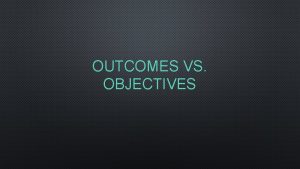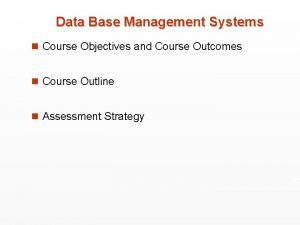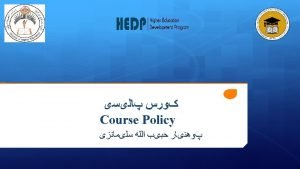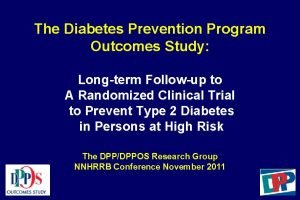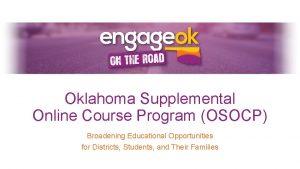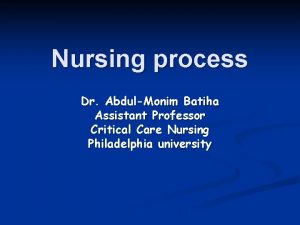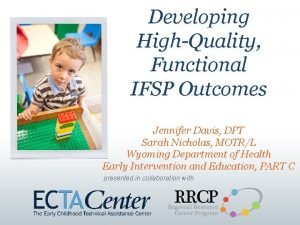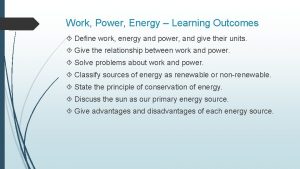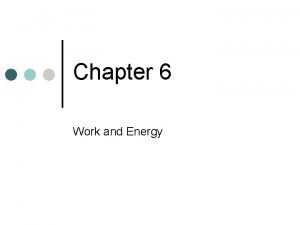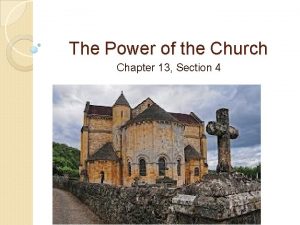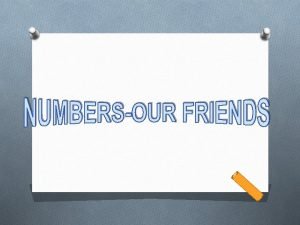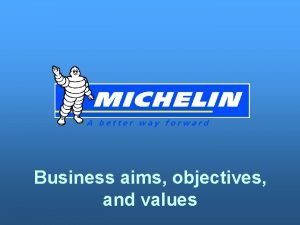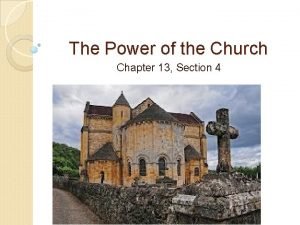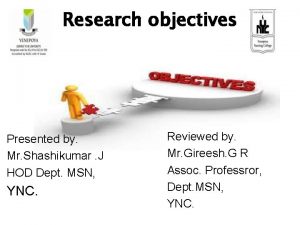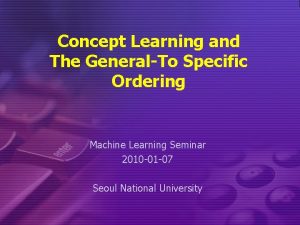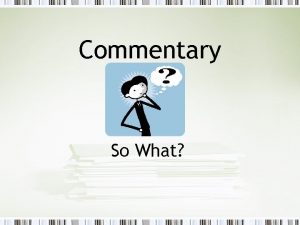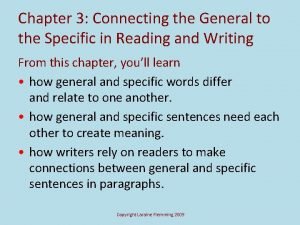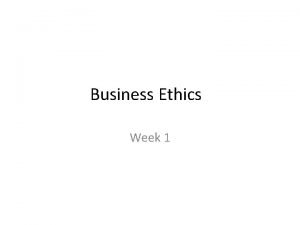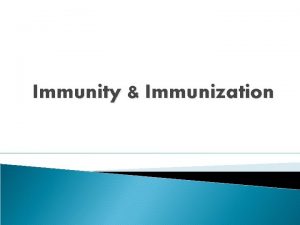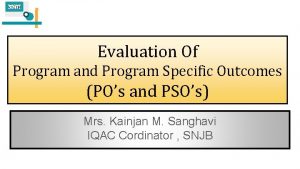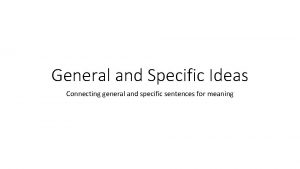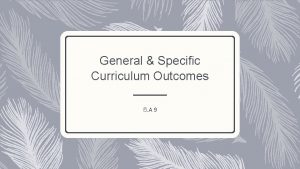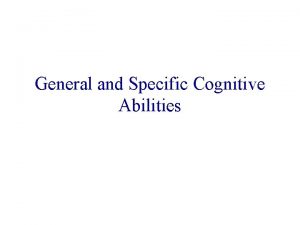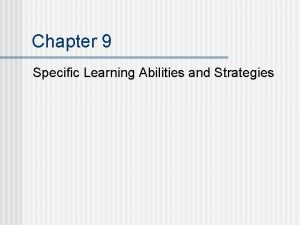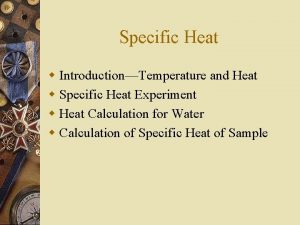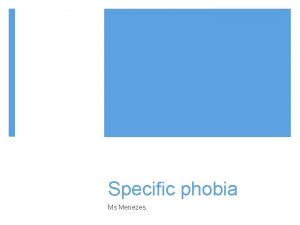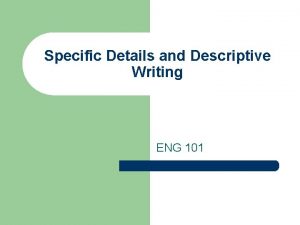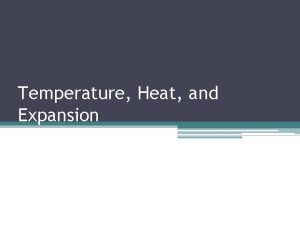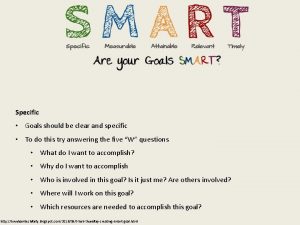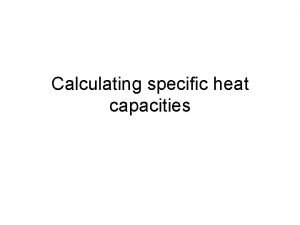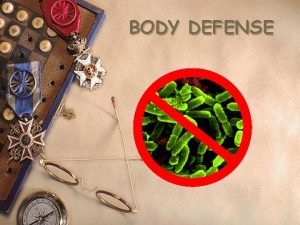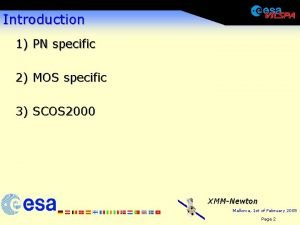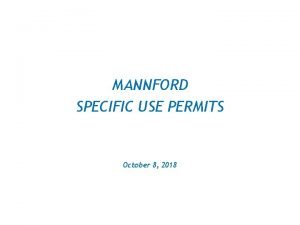Program Outcomes Program Specific Outcomes and Course Outcomes

































- Slides: 33

Program Outcomes, Program Specific Outcomes, and Course Outcomes N J Rao and K Rajanikanth njraoiisc@gmail. com; rajani 341949@yahoo. com

POs and PSOs • What the students become capable of, at the end of the program (PEOs look at the graduates 3 to 4 years after the completion of the program!) • POs (12 in number) are defined by NBA; are applicable to all UG programs; cover not just technology competence but also skills and attitudes! • PSOs are program specific; 2 to 4; need to be defined following a documented process 2

POs and PSOs 3

POs defined by NBA 1. Engineering knowledge: Apply the knowledge of mathematics, science, engineering fundamentals, and an engineering specialization to the solution of complex engineering problems. 2. Problem analysis: Identify, formulate, research literature, and analyze complex engineering problems reaching substantiated conclusions using first principles of mathematics, natural sciences, and engineering sciences. 4

POs defined by NBA (2) 3. Design/development of solutions: Design solutions for complex engineering problems and design system components or processes that meet the specified needs with appropriate consideration for the public health and safety, and the cultural, societal, and environmental considerations. 4. Conduct investigations of complex problems: Use research-based knowledge and research methods including design of experiments, analysis and interpretation of data, and synthesis of the information to provide valid conclusions. 5

POs defined by NBA (3) 5. Modern tool usage: Create, select, and apply appropriate techniques, resources, and modern engineering and IT tools including prediction and modeling to complex engineering activities with an understanding of the limitations. 6. The engineer and society: Apply reasoning informed by the contextual knowledge to assess societal, health, safety, legal, and cultural issues and the consequent responsibilities relevant to the professional engineering practice. 6

POs defined by NBA (4) 7. Environment and sustainability: Understand the impact of the professional engineering solutions in societal and environmental contexts, and demonstrate the knowledge of, and need for sustainable development. 8. Ethics: Apply ethical principles and commit to professional ethics and responsibilities and norms of the engineering practice. 9. Individual and team work: Function effectively as an individual, and as a member or leader in diverse teams, and in multidisciplinary settings. 7

POs defined by NBA (5) 10. Communication: Communicate effectively on complex engineering activities with the engineering community and with society at large, such as, being able to comprehend and write effective reports and design documentation, make effective presentations, and give and receive clear instructions. 11. Project management and finance: Demonstrate knowledge and understanding of the engineering and management principles and apply these to one’s own work, as a member and leader in a team, to manage projects and in multidisciplinary environments. 8

POs defined by NBA (6) 12. Life-long learning: Recognize the need for, and have the preparation and ability to engage in independent and life-long learning in the broadest context of technological change. 9

Program Specific Outcomes (PSOs): • Beyond POs • Specific to the particular program • 2 to 4 in number • Must have a process for arriving at them • Must be realistic • Program Curriculum and other activities during the program must help the achievement of PSOs as with POs! 10

PSOs - Examples CSE: (Stem as with POs) • Design, develop, test, and maintain Software Systems for business applications • Design, develop, test, and maintain Systems Software. • Maintain legacy software systems 11

PSOs - Examples ECE: (Stem as with POs) • Specify, design, prototype and test modern electronic systems that perform analog and digital signal processing functions. • Architect, partition, and select appropriate technologies for implementation of a specified communication system. 12

PSOS – EXERCISES 13

Course Outcomes 14

Students learn well when • They are clear about what they should be able to do at the end of a course • Assessment is in alignment with what they are expected to do • Instructional activities are designed and conducted to facilitate them to acquire what they are expected to achieve

Assessment • Understanding what students know and are able to do as a result of their engineering education is fundamental to students success and to the quality and effectiveness of engineering education Many academics still view • The assessment of student learning as an obligatory, externally imposed chore of compliance and accountability

Assessment • Gathering evidence of students learning is not compliance with external demands but rather, an institutional strategy, a core function of continuous improvement and a means for faculty to elevate student success and strengthen institutional health

Outcomes of Learning • When we teach we want our students to learn. • Outcomes of any learning: Outcomes, Course Outcomes, Learning Outcomes, Intended Learning Outcomes, Instructional Objectives, Educational Objectives, Behavioral Objectives, Performance Objectives, Terminal Objectives, Subordinate Skills,

What is Course Outcome? • Course Outcomes are what the student should be able to do at the end of a course • It is an effective ability, including attributes, skills and knowledge to successfully carry out some activity which is totally identified • The most important aspect of a CO is that it should be measurable 19

Structure of a CO Statement • Action: Represents a cognitive/ affective/ psychomotor activity the learner should perform. An action is indicated by an action verb representing the concerned cognitive process. • Knowledge: Represents the specific knowledge from any one or more of the eight knowledge categories • Conditions: represents the process the learner is expected to follow or the conditions under which to perform the action (This is an optional element of CO) • Criteria: represent the parameters that characterize the acceptability levels of performing the action (This is an optional element of CO) 20

Sample 1 Determine the input-output characteristics of active two-port networks using Microcap simulator and TI Analog Laboratory unit and compare their characteristics as obtained by simulation and Lab Unit • Action: Determine(Apply) • Knowledge: input-output characteristics of active two-port networks (Conceptual) • Condition: using Microcap simulator and TI Analog Laboratory unit • Criteria: compare its characteristics as obtained by simulation and Lab Unit 21

Sample 2 Macro model signal processing functions of resistors, capacitors, inductors, crystals, diodes, Amplifiers, Op Amps, Comparators and Multipliers as one-port and two-port networks • Action: Macromodel (Understand) • Knowledge: signal processing functions of …… (Conceptual and Procedural) • Condition: One-port and two-port networks • Criteria: None 22

Sample 3 Calculate major and minor losses associated with fluid flow in piping networks • Action: Calculate (Apply) • Knowledge: major and minor losses associated with fluid flow in piping networks (Conceptual and Procedural) • Condition: None • Criteria: None 23

Sample 4 Determine the dynamic unbalanced conditions of a given mechanical system of rigid objects subjected to force and acceleration • Action: Determine (Apply) • Knowledge: Dynamic unbalanced conditions (Conceptual and Procedural) • Condition: given mechanical system of rigid objects subjected to force and acceleration • Criteria: None 24

Dos and Don’ts • Use only one action verb • Do not use words including ‘like’, ‘such as’, ‘different’, ‘etc. ’ with respect to knowledge elements. Enumerate all the knowledge elements. • Put in effort to make the CO statement as specific as possible and measurable • Do not make it either too abstract or too specific 25

Check List 1. Does the CO begin with an action verb (e. g. , state, define, explain, calculate, determine, identify, select, design)? 2. Is the CO stated in terms of student performance (rather than teacher performance or subject matter to be covered)? 3. Is the CO stated as a learning product (rather than in terms of the learning process)? 4. Is the CO stated at the proper level of generality and relatively independent of other COs (i. e. , is it clear, concise, and readily definable)? 5. Is the CO attainable (do they take into account students’ background, prerequisite competences, facilities, time available and so on)? 26

COS: Your comments please! Students will execute mini projects Instructional activities are designed to facilitate the attainment of COs by learners, but themselves are not COs Have the concepts of compensators and controllers (P, PD, PID) COs are competencies / behaviors that can be demonstrated; not descriptions of internal changes in the students (though these are necessary) 27

COS: Your comments please! (cont’d) Optimal Generator scheduling for thermal power plants by using software package in the lab No action verb; no way of assessing; no way of determining attainment level; syllabus part is rewritten. Will get knowledge of protection schemes for Generator, Transformer and Induction Motor COs are competencies / behaviors that can be demonstrated; not descriptions of internal changes in the students (though these are necessary)- See the comments in the previous slide! 28

COS: Your comments please! (cont’d) Apply problem solving techniques to find solutions to problems. Too general; no clear way of assessing! Study variety of advanced abstract data type (ADT) and data structures and their Implementations Activity that the student engages in during the Course; not what he / she becomes capable of demonstrating at the end of the course? 29

COS: Your comments please! (cont’d) Know the stress strain relation for a body subjected to loading within elastic limit. See the earlier comment; Not an action that can be demonstrated; Internal change Students will be able to learn the structure, properties and applications of modern metallic materials, smart materials non-metallic materials and advanced structural ceramics. An outcome? How to assess? 30

COS: Your comments please! (cont’d) Students will be aware of base band signal concepts and different equalizers. See the earlier comment; Not an action that can be demonstrated; Internal change Get complete knowledge regarding adaptive systems See the earlier comment; Not an action that can be demonstrated; Internal change; Too ambitious to be realistic? 31

Exercise Write a set of COs a student should acquire at the end of your course, emphasizing particularly the relevant higher cognitive levels. • Make sure that the CO does not appear to be like a single question. • Avoid using the action verbs Apply, Analyze, Evaluate and Create. Use the action verbs associated with these cognitive levels. • Mark the number of classroom sessions you would need to conduct the instructional activities for each competency 32

Thank You njraoiisc@gmail. com; rajani 341949@yahoo. com 33
 Program specific outcomes nba
Program specific outcomes nba Course outcomes vs objectives
Course outcomes vs objectives Dbms course outcomes
Dbms course outcomes Course number and title
Course number and title Specific weight glycerin
Specific weight glycerin Plummet method
Plummet method Course specific policy
Course specific policy What is esp english for specific purposes
What is esp english for specific purposes Building with bricks
Building with bricks Course interne course externe
Course interne course externe Diabetes prevention program outcomes study
Diabetes prevention program outcomes study Oklahoma supplemental online course program
Oklahoma supplemental online course program Nursing process planning phase
Nursing process planning phase Planning goals and learning outcomes
Planning goals and learning outcomes Collaborative interventions nursing
Collaborative interventions nursing Learning objectives for direct and indirect speech
Learning objectives for direct and indirect speech Output devices purpose
Output devices purpose Examples of ifsp outcomes and strategies
Examples of ifsp outcomes and strategies Learning outcomes of work and energy
Learning outcomes of work and energy Learning outcomes of profit and loss
Learning outcomes of profit and loss Learning outcomes of work and energy
Learning outcomes of work and energy The power of the church chapter 13 section 4
The power of the church chapter 13 section 4 Indian and international number system
Indian and international number system Aims objectives and outcomes
Aims objectives and outcomes Otto invades italy on pope's behalf causes and outcomes
Otto invades italy on pope's behalf causes and outcomes Ancient rome outcomes geography and early republic
Ancient rome outcomes geography and early republic Sequential program and an event-driven program?
Sequential program and an event-driven program? الوزن النوعي
الوزن النوعي Nursing research objectives
Nursing research objectives Subjective maturity indices
Subjective maturity indices Explain general to specific ordering of hypothesis
Explain general to specific ordering of hypothesis Concrete detail definition
Concrete detail definition General and specific words
General and specific words Specific and pervasive boundaries for behavior
Specific and pervasive boundaries for behavior

